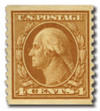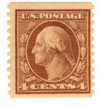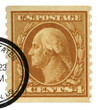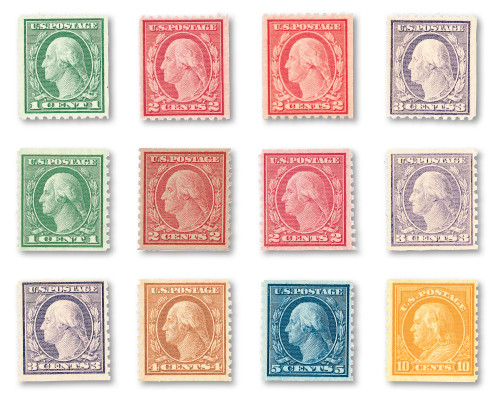
1917 4c Washington, orange brown, vertical perf 10
# 495 - 1917 4c Washington, orange brown, vertical perf 10
$5.00 - $105.00
U.S. #495
1916-22 4¢ Washington
1916-22 4¢ Washington
Issue Date: April 15, 1917
Printed by: Bureau of Engraving and Printing
Printing Method: Rotary Press
Watermark: None
Perforation: 10 vertically
Color: Orange brown
The Series of 1916-22 vertical coil stamps were produced on plates of 150 subjects each. An estimated 67 million U.S. #495 stamps were issued. It fulfilled the domestic mail rate for letters weighing one to two ounces, until postal rates jumped during World War I.
First Unwatermarked U.S. Stamps
In 1916, the Bureau of Engraving and Printing began producing stamps on unwatermarked paper. With the United States already close to a wartime economy as World War I raged in Europe, the lower cost of single mark paper added up to big savings for the Bureau. However, single watermarks on previous stamps were often quite hard to identify, and collectors were slow to recognize that a new type of paper was being used.
Mail During World War I
One of the major problems for the U.S. during World War I was the establishment of mail service to the American Expeditionary Forces (AEF) in France. Shortly after the United States declared war on Germany, it became necessary to organize a postal system for the American troops overseas. On June 13, 1917, Postmaster General Albert Burnham authorized the establishment of mail agencies in France. Marcus Bunn, assistant superintendent of the Railway Mail Service, was appointed as Postal Agent in Charge. Soon after his arrival in Paris on June 30th, he began making arrangements for “The United States Mail Agency in France.”
Meanwhile, back home, a distribution center was established at the Chelsea Terminal in New York City. Here, all outgoing mail was processed and then forwarded to Hoboken Port of Embarkation. On the other side of the ocean, centers were organized to receive incoming mail and distribute it to the soldiers.
Troops began arriving in France as early as June 14, 1917, but the first mail agency was not set up until nearly a month later. An official bulletin relates the tale. As the first troops of the American Expeditionary Force were preparing to leave the Port of Arrival, General Pershing inquired of the United States Postal Agent, “How soon can postal facilities be provided?”
Bunn replied, “I can leave by the first train, after two hours.”
Pershing then asked, “I mean how soon can you have working force there?”
“I shall take my force with me,” was Bunn’s answer.
Two hours and twenty minutes later, Bunn and his three men boarded a train and arrived at the campsite within an hour. An empty building was located and extra supplies, such as packing boxes and distribution cases were set up to hold the mail. The first U.S. Army Post Office (APO), APO Number 1, was established in St. Nazaire, and APO Number 2 followed shortly thereafter in Paris.
U.S. #495
1916-22 4¢ Washington
1916-22 4¢ Washington
Issue Date: April 15, 1917
Printed by: Bureau of Engraving and Printing
Printing Method: Rotary Press
Watermark: None
Perforation: 10 vertically
Color: Orange brown
The Series of 1916-22 vertical coil stamps were produced on plates of 150 subjects each. An estimated 67 million U.S. #495 stamps were issued. It fulfilled the domestic mail rate for letters weighing one to two ounces, until postal rates jumped during World War I.
First Unwatermarked U.S. Stamps
In 1916, the Bureau of Engraving and Printing began producing stamps on unwatermarked paper. With the United States already close to a wartime economy as World War I raged in Europe, the lower cost of single mark paper added up to big savings for the Bureau. However, single watermarks on previous stamps were often quite hard to identify, and collectors were slow to recognize that a new type of paper was being used.
Mail During World War I
One of the major problems for the U.S. during World War I was the establishment of mail service to the American Expeditionary Forces (AEF) in France. Shortly after the United States declared war on Germany, it became necessary to organize a postal system for the American troops overseas. On June 13, 1917, Postmaster General Albert Burnham authorized the establishment of mail agencies in France. Marcus Bunn, assistant superintendent of the Railway Mail Service, was appointed as Postal Agent in Charge. Soon after his arrival in Paris on June 30th, he began making arrangements for “The United States Mail Agency in France.”
Meanwhile, back home, a distribution center was established at the Chelsea Terminal in New York City. Here, all outgoing mail was processed and then forwarded to Hoboken Port of Embarkation. On the other side of the ocean, centers were organized to receive incoming mail and distribute it to the soldiers.
Troops began arriving in France as early as June 14, 1917, but the first mail agency was not set up until nearly a month later. An official bulletin relates the tale. As the first troops of the American Expeditionary Force were preparing to leave the Port of Arrival, General Pershing inquired of the United States Postal Agent, “How soon can postal facilities be provided?”
Bunn replied, “I can leave by the first train, after two hours.”
Pershing then asked, “I mean how soon can you have working force there?”
“I shall take my force with me,” was Bunn’s answer.
Two hours and twenty minutes later, Bunn and his three men boarded a train and arrived at the campsite within an hour. An empty building was located and extra supplies, such as packing boxes and distribution cases were set up to hold the mail. The first U.S. Army Post Office (APO), APO Number 1, was established in St. Nazaire, and APO Number 2 followed shortly thereafter in Paris.


















